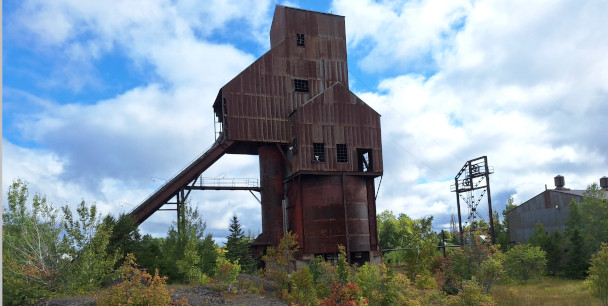Michigan’s Copper Legacy:
A Journey from Ancient Mines to Modern Treasures
In Michigan’s wild Upper Peninsula, particularly the rugged Keweenaw Peninsula, copper has shaped a saga spanning thousands of years. From the stone tools of ancient Native Americans to the industrial boom that powered a nation, the region’s copper—prized for its near-perfect purity—stands out as a geological marvel. Unlike the complex ores mined elsewhere, Michigan’s native copper emerges from the earth ready to use, a quality that has defined its value and allure. This is the story of Michigan’s copper mining, from prehistoric pits to today’s quiet mine dumps, and why its metal remains a global standout.
Ancient Beginnings: Native American Copper Craft
Long before modern machinery, the Upper Peninsula’s indigenous peoples were the first to tap its copper riches. Thousands of years ago, tribes in the Keweenaw and Isle Royale used simple stone hammers to pry gleaming nuggets from shallow pits and glacial deposits. They crafted these into tools like knives and fishhooks, as well as intricate ornaments that traveled vast trade routes across North America. The copper’s natural purity meant it could be shaped without fire—just pounded into form, a testament to both the metal’s quality and the ingenuity of these early miners. Their small, hand-dug pits, some reaching 30 feet deep, marked the dawn of a resource that would echo through history.
European Arrival: The Spark of a New Era
When European explorers reached the Great Lakes in the 1600s, tales of “red metal” piqued their curiosity. Fur traders and missionaries noted the natives’ copper tools, but the region’s remoteness kept large-scale mining at bay. That changed in the 1840s, when treaties opened the land to American prospectors. The discovery of massive copper deposits near Eagle Harbor in 1845 triggered a rush. Early mines relied on skilled Cornish immigrants, who brought expertise in digging through tough basalt rock. Towns like Houghton and Copper Harbor sprang up, turning the wilderness into a hive of ambition as miners chased veins of shimmering metal.
The Golden Age: Copper Fuels a Nation
By the late 1800s, Michigan’s copper mines were an industrial powerhouse. The Keweenaw’s richest operations, like the sprawling Calumet and Hecla mines, churned out millions of pounds of copper yearly, fueling America’s growth. This metal wired telegraphs, powered early electricity, and built the machinery of the Industrial Revolution. Miners dug ever deeper, some shafts plunging over a mile underground, using steam-powered tools to crush rock and extract the prize. The boom drew waves of immigrants—Finns, Italians, and others—creating vibrant communities amid the pines. Yet, the work was grueling, marked by strikes and tragedies as laborers fought for better conditions. At its peak, Michigan supplied much of the nation’s copper, its mines a beating heart of progress.
Decline and Transition: A Fading Industry
The early 20th century saw Michigan’s dominance wane. By the 1920s, vast open-pit mines in places like Arizona offered cheaper copper from lower-grade ores. Michigan’s deep, pure deposits became costly to extract as the easiest veins ran dry. After World War II, the focus shifted to sulfide ores at places like the White Pine Mine, which kept the industry alive until its closure in 1995. The mines fell silent, leaving behind ghost towns, crumbling engine houses, and piles of discarded rock. The Keweenaw pivoted to tourism, with its history preserved in museums and trails where visitors can walk in the miners’ footsteps.
Modern Prospects: A New Chapter?
Today, Michigan’s copper mines are largely relics, but the story isn’t over. Rising demand for copper in electric vehicles and green energy has sparked fresh interest. Projects like the Copperwood Mine in Gogebic County aim to revive the industry with modern, eco-conscious methods, though environmental concerns pose challenges. Exploration continues in the Keweenaw, where old veins might hold untapped potential. For now, the region’s copper legacy lives on through its historic sites and the collectors who scour its shores and mine dumps for treasures.
The Purity That Sets Michigan Apart
What makes Michigan’s copper extraordinary is its native form—found as nearly pure metal, often 99.9% pure, unlike the low-grade ores mined in places like Chile or Australia. Those global deposits, typically containing just 0.5-2% copper, require intensive processing to refine. Michigan’s copper, by contrast, could be used straight from the ground, hammered or melted with minimal effort. This purity gave it a premium value historically, perfect for high-conductivity needs like electrical wiring. Even today, its unique quality makes it a collector’s gem, prized for both its beauty and its rarity in a world of processed ores.
Mine Dump Treasures: A Collector’s Paradise
For rockhounds, Michigan’s abandoned mine dumps are a siren call. These heaps of basalt and conglomerate, scattered across the Keweenaw, are studded with native copper and minerals like agates, prehnite, and chlorastrolite. Collectors flock to sites like the Quincy or Central Mine dumps, sifting through rubble for “float copper”—nuggets polished by glaciers or waves. These pieces, ranging from tiny flecks to fist-sized chunks, fetch high value for their purity and history. Polished into jewelry or displayed raw, they can sell for tens to hundreds of dollars, depending on size and quality. The thrill of unearthing a gleaming copper vein or a gem-filled basalt makes these dumps a living legacy, connecting collectors to Michigan’s ancient and industrial past.
Shop Now: Michigan Rocks And Wood

